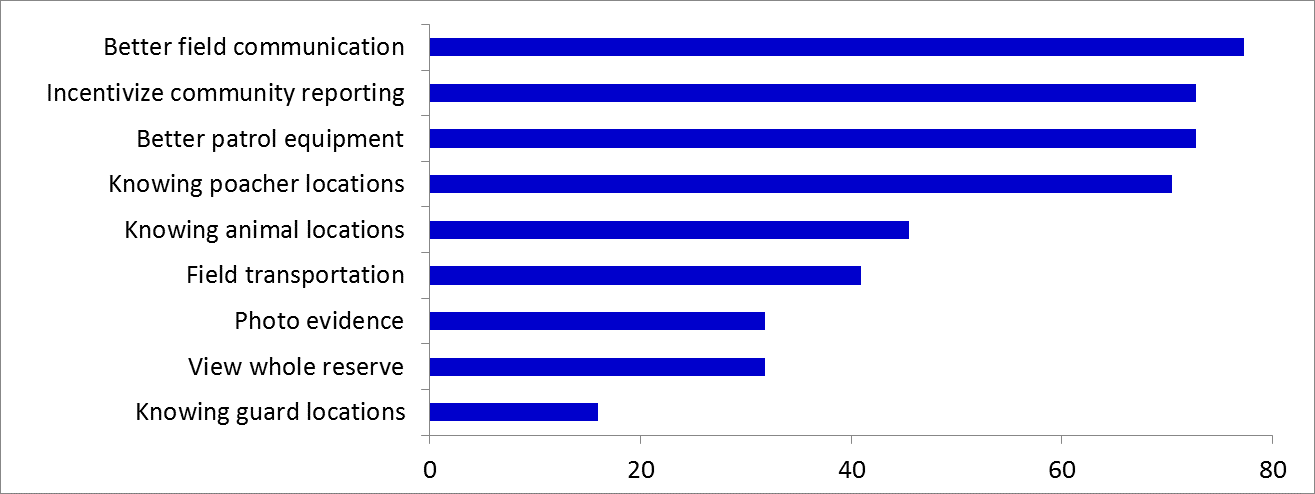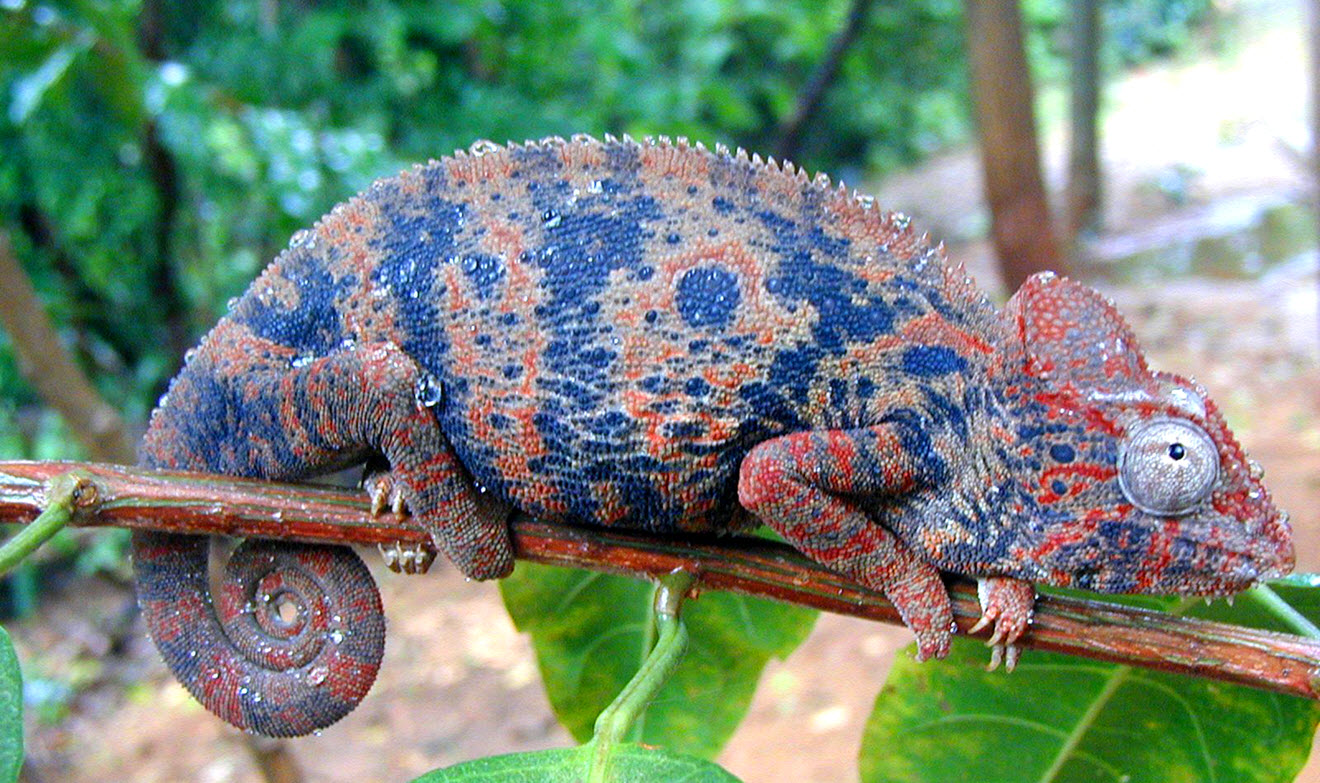- The concurrent challenges of remoteness, extreme temperatures, dust, high rainfall and humidity, dense vegetation and steep terrain all complicate and limit the use of existing and emerging technologies for nature conservation and research.
- Survey responses of front-line conservationists suggest that no single technology will stop either wildlife poaching or human-wildlife conflict.
- Researchers everywhere desire smaller, lighter, longer-lasting, and more affordable devices that better withstand humidity, dust and damage.
- Integrated, automated devices and systems for detecting, monitoring, and providing early warning of movements of people and animals would revolutionize conservation and research work across species, ecosystems, and countries.
What challenges do wildlife managers and researchers face most frequently in the field?
And what technology advances can help address them?
To help ensure wildtech-mongabay-com.mongabay.com remains a useful tool for readers, we invited front-line conservationists and researchers, representing a range of institutions and field conditions, to fill out anonymous questionnaires, with a separate questionnaire for each group. We asked them describe the challenges they face in their work, current means of addressing these challenges, capacities that could increase their effectiveness, and any game-changing technologies that would revolutionize their work.
We received responses from 44 front-line conservationists from 14 countries and from 50 wildlife biologists working in 37 countries on technology they use currently, problems they face with it, and how they would improve it.
Click here for a detailed report of the survey results.

Major conservation challenges
A. The Front-Line Conservationists (FLCs), from the non-profit and public sectors, work primarily on-site at protected areas or within government parks or wildlife departments, with a relative concentration of responses from South Asia and East Africa.
Most have multiple responsibilities, including controlling poaching and other crimes, maintaining community relations, mitigating human-wildlife conflict, surveying wildlife and their habitats, training staff or colleagues, analyzing data, raising funds or public awareness and managing a conservation area.
Nearly every FLC respondent said that wildlife poaching was a serious problem. Human-wildlife conflict (HWC), was identified as the second major challenge (60% of respondents), with habitat loss, encroachment and infrastructure development currently less urgent issues.
Poaching challenges:
- According to respondents, poachers primarily use guns and snares to kill wild ungulates (deer, pigs, zebra), big cats, elephants and rhinos, nearly always at night. They kill in both protected and unprotected areas, generally far from people (Figure 1).

- Sites of nearly 80% of respondents use patrols to combat poaching; though 30% of these added that resource and manpower constraints, including limited ability to work at night, restricted patrol effectiveness.
- Respondents identified an array of different capacities that would help them address poaching more effectively (Figure 2), suggesting that no one technology is sufficient to address this problem. More successful patrol efforts were associated with intelligence from local communities and the ability to surprise poachers, and the group particularly wished for technologies that facilitate field communication among rangers and informing them of the whereabouts of poachers and target animals.

Human-wildlife conflict (HWC) challenges:
- HWC involves the raiding of crops or livestock by large animals and the retaliation by farmers, who may encourage or engage in the killing of “problem” animals.
- Animals involved included primates (over 60%), big cats (67%), wild ungulates (74%) and elephants (88%), though people frequently come into conflict with multiple species
- HWC occurs primarily at night in ripening crop fields, but also in villages and buffer zones where people are present (Figure 3).

- No single current HWC reduction method was cited by a majority of respondents, suggesting there is still no clear solution to this problem (Figure 4). Electric fencing–when maintained properly–had highest ratings for effectively reducing crop and livestock raiding, but maintaining the fencing poses logistical and financial challenges.

- The conservationists overwhelmingly want ways to safely keep animals away from human areas in the first place (Figure 5), with keen interest in better understanding animal movements generally and specifically, in relation to locations of crops and livestock.

B. The wildlife biologists answered more open-ended questions about their research questions, study species and habitats, the technology they use and its limitations. Most specialized in larger vertebrates, conducting research on questions of species’ ecology, habitat use, and the impacts of human activities on wildlife.
Environmental challenges:
- Harsh environmental conditions challenge existing technologies: Nearly 75% of the researchers face environmental conditions (dense forest, steep terrain, extreme temperatures, rainfall, and humidity) that preclude current use of certain technologies. Some tools may be available at military grade quality and prices but are out of range of NGOs and wildlife or parks departments.
- Poor communications (RF connectivity): The remoteness of some study sites makes mobile connections and the testing and installation of devices difficult.
Technical challenges:
- Insufficient battery power – Most field equipment must be portable and thus battery-powered; a scientist from Smithsonian Institution summed up the community sentiment: “I wish battery life could be extended for everything – hand-held radios, sat phones, drills, computers, headlamps, etc. And lighter is always better.”
- Weight – Balancing weight of batteries and protective coverings with lifespan and durability is another challenge: numerous colleagues echoed the wish by one experienced field biologist for “lighter, sturdier, more robust tracking systems that don’t fail.”

Where technology can make a difference
We asked the two groups to identify game-changing technologies or tools that a team of engineers could build to address their specific research or conservation challenges. We found that the practitioners on the front line and researchers working in remote areas share many of the same technology needs. While responses could not be easily categorized, the respondents’ ideas converged on devices that are:
|
|
|
The wildlife biologists also added devices that are:
- Non-invasive (sample testing, animal tagging)
- Portable (DNA scanners, data collectors)
- Aerial (high-resolution aerial view with real-time video)
A. The Front-Line Conservationists (FLCs)
With multiple responsibilities, the FLCs’ thoughts on game-changing technologies often involved resolving several problems—e.g. poaching, HWC, encroachment—simultaneously.
- Early warning: The respondents overwhelmingly identified the capacity to better detect people and animals in the field with advanced warning would improve their effectiveness on the front line of conservation (Figure 6). One explained, “Anything as an integrated early detection and warning system (and which must be theft-proof) would be useful. Camera traps would be useful independently, as a forensic tool over cattle and human kills to determine which animal carried it out. And to track forest produce extraction and poachers.”
- Improved communications: Over half the FLCs said improved communications (e.g. “Satellite phones that work well under canopy cover”), both among field teams and between tagged animals and observers, would facilitate their work in remote regions, including enabling a coordinated response by rangers to early warnings of disturbance.
- Combining technologies: The FLCs often suggested combining features of various devices to create more effective systems: most of the surveillance systems respondents imagined would also require communication networks to work as early warning systems to know when people are entering protected areas. A combination of existing low-tech methods, including various biological fencing (bees and chili), and emerging technologies–from trip alarms that send SMS messages to solar-powered electric fencing, to improved communication systems to electronic “scarecrows”–may be needed to help address HWC concerns.
- Moonshot 1: “While camera traps that look out for poachers is nothing new…this technology could be truly revolutionary if it was [were] combined with aerial drones. If park officials alerted to poachers in a certain grid could automatically send drones to the area to photograph and even follow the poachers, catching them would be far easier, especially in larger national parks and nature reserves. As drones get more advanced and cheaper to buy and operate, this technology will become more feasible, and there has never been a better time to put them to use in wildlife [conservation].”
- Moonshot 2: “Virtual fences that can detect different animals crossing a certain point and warn farmers of incoming animals and warn rangers of incoming human intruders.”
- Better training: “It should be mandatory for wildlife managers to get [a] certificate course on wildlife management once every two years, where he/she [in which they] should be evaluated about updated technologies to meet the gap between traditional and new outcomes. It might be carried out for new or senior managers.”


B. The wildlife biologists
Researchers across the board desire longer-lasting batteries; smaller, lighter data collection devices, including DNA readers and tracking tags; remote access to camera traps and other sensors, and lower-cost satellite-connected smartphones, sensors and imagery. They also want these long-lasting, lighter, more reliable devices to better withstand humidity, dust and damage, with several types of tools mentioned repeatedly:
- data logging units, including tablets and smartphones, that are lighter, more rugged, longer-lasting
- GPS units that are more reliable and capture and upload under forest canopy
- camera traps that are: low-cost (< $ 100), waterproof, highly reliable, digital, and cryptic with (if possible) thermal imaging, long-lasting batteries, and the ability to recognize fur patterns or humans and automatically alert a base station if certain types of subjects are detected.
- GPS-based animal tracking tags that are lighter, longer-lasting, more reliable and cost less –“…a 2-gram GPS monitoring device for birds with six months of battery life.”
- Moonshot 1: Tags that also collected and transmitted environmental and physiological data or recharged by solar or animal movement.
- a more accurate digital elevation model to produce local topographic maps or real-time access to digital satellite imagery maps in the field.
- communications systems to enable transmission among various data collection devices—including cameras, tracking tags and handheld devices—in remote or hilly areas that preclude access to internet or cellular networks.
- solar-powered cameras, radios and handheld data collection devices or cheaper panels and storage batteries to charge small batteries, run laptops and other equipment and power electric fences or lighting systems.
- hand-held DNA readers with up-to-date reference libraries: “Hand-held DNA readers!?! We could collect fecal DNA and know the species immediately. Great if we could also distinguish prey items and number of prey individuals within scats from predators too.”
- UAVs/drones that are more affordable and easier to fly and land, to be used to autonomously survey animal populations and monitor individual animals day and night.
- Moonshot 2: Capture-free animal tagging (using drones).
Like the FLCs, researchers highlighted ideas that combined technologies, including remote-controlled or automated triggers of cameras or alerts and improved communication among aerial, vehicle and ground sensors (e.g. cameras), tracking tags, data collection devices and satellites.
Both groups identified real-time animal monitoring as a game-changing technology, but biologists aimed to better understand animal ranging and habitat use, while conservationists wanted to detect gunshots and animal movements to alert rangers to poacher presence.
Nonetheless, the desire, even among researchers, for technologies, such as hidden cameras or thermal-image goggles to record wildlife crime, or long-lasting RFID tags that can detect and thwart poachers, shows their concern for their study species and the impact of human disturbance on research as well as conservation areas.

You can read a report of the survey results, which we will continue to use to help inform the content of wildtech-mongabay-com.mongabay.com and encourage the advancement of technologies that could improve the conservation and research of wildlife and wild places.
We encourage you to brainstorm, suggest and test possible solutions, and contact colleagues who could contribute their knowledge and experience to addressing any of the challenges identified by the respondents!
